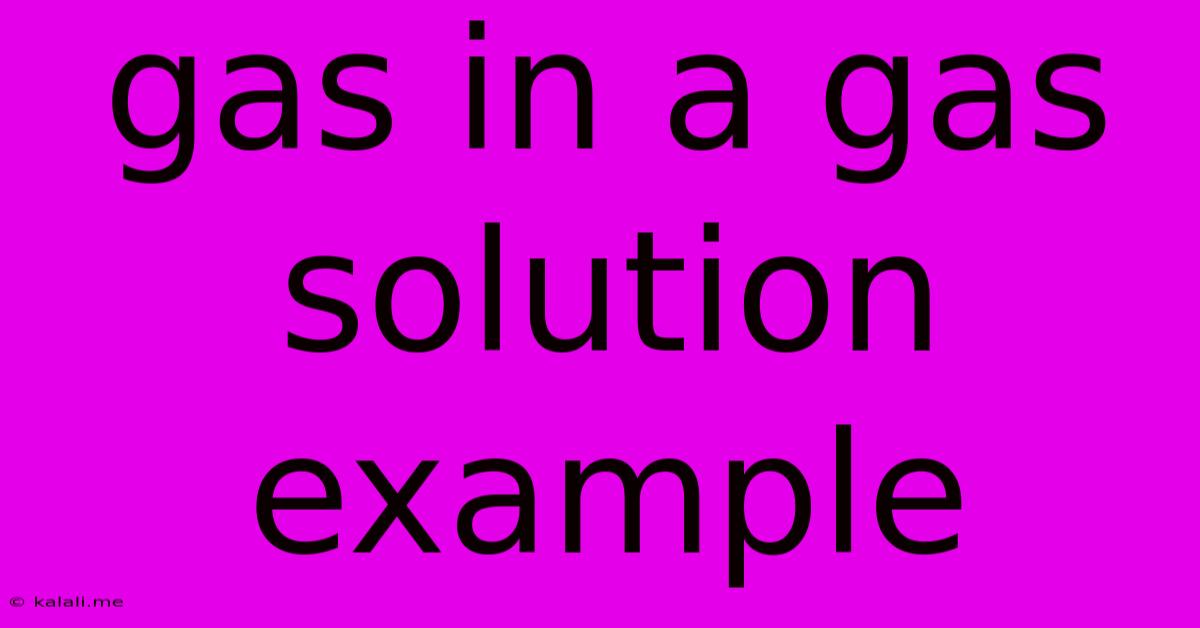Gas In A Gas Solution Example
Kalali
May 10, 2025 · 4 min read

Table of Contents
Understanding Gas in a Gas Solution: Examples and Applications
Meta Description: Explore the fascinating world of gas dissolved in gas solutions. This article delves into examples, applications, and the underlying principles governing this phenomenon. Learn about the factors affecting solubility and its relevance in various fields.
Gas dissolved in gas solutions might seem counterintuitive – after all, gases are known for their expansive nature. However, gases can indeed dissolve in other gases, forming homogenous mixtures. This phenomenon is governed by several factors, including pressure, temperature, and the chemical nature of the gases involved. Understanding gas-in-gas solutions is crucial in several scientific and industrial applications.
What is a Gas in a Gas Solution?
A gas in a gas solution refers to a homogeneous mixture where one gas is dissolved within another gas. Unlike liquid or solid solutions, the interactions between the gas molecules are relatively weak, primarily governed by van der Waals forces. The solubility of one gas in another depends heavily on the partial pressures of each gas and their molecular structures.
Examples of Gas in a Gas Solution
Numerous examples exist in nature and industrial processes. Here are a few prominent examples:
- Air: The most common example is air itself. Air is a solution of several gases, primarily nitrogen (approximately 78%), oxygen (approximately 21%), and argon (approximately 1%), along with trace amounts of carbon dioxide, neon, helium, and other gases. The gases are mixed homogeneously, with each gas contributing its partial pressure to the total atmospheric pressure.
- Natural Gas: This mixture comprises primarily methane, with varying amounts of ethane, propane, butane, and other hydrocarbon gases, along with impurities like nitrogen and carbon dioxide. Each gas contributes to the overall composition and properties of the natural gas solution.
- Diving Gas Mixtures: Divers often use specialized gas mixtures, such as Nitrox (nitrogen and oxygen) or Trimix (nitrogen, oxygen, and helium), to manage the effects of pressure at depth. These mixtures are meticulously calculated to optimize breathing and minimize risks associated with high-pressure environments. The solubility of the gases at depth is a critical safety consideration.
- Industrial Gas Mixtures: Many industrial processes use carefully controlled mixtures of gases. For example, in the production of ammonia, a mixture of nitrogen and hydrogen is used, where the solubility of each gas in the mixture influences the reaction efficiency.
- Combustion Gases: The exhaust from combustion processes like power generation or internal combustion engines is a complex mixture of gases, including carbon dioxide, water vapor, nitrogen oxides, and various other combustion products.
Factors Affecting Gas Solubility in Gases
Several factors influence how much of one gas can dissolve in another:
- Pressure: According to Henry's Law, the solubility of a gas in a liquid (and to a lesser extent, in another gas) is directly proportional to the partial pressure of that gas above the solution. Increasing the partial pressure of a gas increases its solubility.
- Temperature: Generally, the solubility of a gas decreases with increasing temperature. Higher temperatures impart more kinetic energy to the gas molecules, making them less likely to remain dissolved.
- Molecular Interactions: The strength of intermolecular forces between the gas molecules influences solubility. Gases with similar molecular sizes and polarities tend to be more soluble in each other.
Applications of Gas in Gas Solutions
Understanding gas-in-gas solutions has significant applications across various fields:
- Environmental Science: Studying atmospheric composition and the behavior of greenhouse gases relies on understanding gas solubility and mixing in the atmosphere.
- Chemical Engineering: Gas solubility is crucial in designing and optimizing industrial processes involving gas mixtures, such as gas separation, purification, and chemical reactions.
- Material Science: The study of gas solubility in materials is important in developing new materials with specific properties, such as gas-selective membranes.
- Medicine: Understanding gas solubility is important in the development of anesthetic gas mixtures and in hyperbaric oxygen therapy.
Conclusion
Gas in gas solutions, while less intuitively obvious than other solution types, are ubiquitous in nature and essential in various industrial processes. Understanding the factors governing gas solubility and mixing is vital for advancements across many scientific and engineering disciplines. Further research into the behavior of gas-in-gas solutions promises exciting developments in numerous fields.
Latest Posts
Latest Posts
-
How Long Does It Take For Brandy Melville To Ship
Jul 13, 2025
-
How Many Times Does 3 Go Into 30
Jul 13, 2025
-
In What Episode Of Bleach Does Ichigo Ask Orihime Out
Jul 13, 2025
-
How Much Is 4 Oz Chocolate Chips
Jul 13, 2025
-
How Many Times Does 9 Go Into 70
Jul 13, 2025
Related Post
Thank you for visiting our website which covers about Gas In A Gas Solution Example . We hope the information provided has been useful to you. Feel free to contact us if you have any questions or need further assistance. See you next time and don't miss to bookmark.